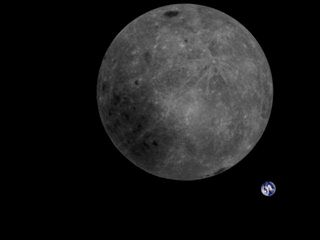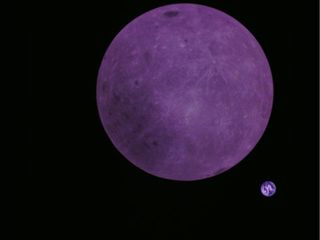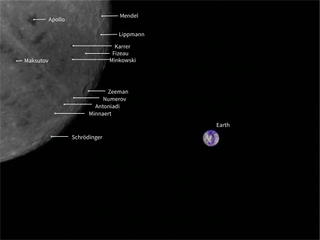Earth Plays 'Peekaboo' with the Moon in This Awesome Far Side Time-Lapse Video
A Chinese satellite orbiting Earth's moon has been snapping some amazing images from the lunar far side, otherwise known as the "dark side of the moon."
Longjiang-2, also known as DSLWP-B, is one of two microsatellites China launched to the moon last year to prepare for the arrival of its Chang'e 4 lander-rover combo mission, which touched down on the far side of the moon on Jan. 3. Its sister satellite, Longjiang-1, failed to achieve orbit, whereas Longjiang-2 has been successfully orbiting and observing the moon since May 2018.
A new photo captured by Longjiang-2 on Monday (Feb. 4) reveals the so-called "dark side of the moon" basking in sunlight as Earth photobombs the moon in the background. The term "dark side" is really a misnomer for the moon's far side — just because we can't see the far side from Earth, doesn't mean that the sun never shines there. Longjiang-2 captured this photo during the new moon, when the Earth-facing side of the moon was completely dark and the far side was entirely illuminated instead. [Watch the Longjiang-2 video of Earth from the Moon's Far Side!]

Longjiang-2 beams photos of the moon back to Earth via the Dwingeloo Radio Observatory in the Netherlands, where astronomers have volunteered to help China's space agency receive the images using the observatory's super-sensitive radio antenna.
Among other instruments, the microsatellite contains a tiny radio transmitter with a webcam the size of a smartphone camera, Tammo Jan Dijkema, an engineer with the Netherlands Institute for Radio Astronomy, explained in an interview with the Dutch news network RTV. The camera was built by students at the Harbin Institute of Technology in China.

The little webcam is limited to a resolution of 640x480 pixels, so the images are "not very clear," Dijkema told RTV, "but we're doing our best with the constraints that we have to take the most beautiful photos possible." (Dijkema's remarks have been translated from the Dutch language.)
Given the camera's the low resolution, Longjiang-2 has provided some impressively detailed images of the lunar surface. "The far side of the moon has many more visible craters than the side of the moon that we can see from Earth," Dijkema wrote in a blog post about the latest image.
Get the Space.com Newsletter
Breaking space news, the latest updates on rocket launches, skywatching events and more!

You can see more photos from Longjiang-2 and learn more about the Dwingeloo telescope via the observatory's blog at camras.nl.
Email Hanneke Weitering at hweitering@space.com or follow her @hannekescience. Follow us on Twitter @Spacedotcom and on Facebook. Original article on Space.com.
Join our Space Forums to keep talking space on the latest missions, night sky and more! And if you have a news tip, correction or comment, let us know at: community@space.com.

Hanneke Weitering is a multimedia journalist in the Pacific Northwest reporting on the future of aviation at FutureFlight.aero and Aviation International News and was previously the Editor for Spaceflight and Astronomy news here at Space.com. As an editor with over 10 years of experience in science journalism she has previously written for Scholastic Classroom Magazines, MedPage Today and The Joint Institute for Computational Sciences at Oak Ridge National Laboratory. After studying physics at the University of Tennessee in her hometown of Knoxville, she earned her graduate degree in Science, Health and Environmental Reporting (SHERP) from New York University. Hanneke joined the Space.com team in 2016 as a staff writer and producer, covering topics including spaceflight and astronomy. She currently lives in Seattle, home of the Space Needle, with her cat and two snakes. In her spare time, Hanneke enjoys exploring the Rocky Mountains, basking in nature and looking for dark skies to gaze at the cosmos.